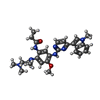Entry Database : PDB / ID : 9by4Title Co-crystal structure of the kinase domain of EGFR with non-covalent osimertinib Epidermal growth factor receptor Keywords / / / Function / homology Function Domain/homology Component
/ / / / / / / / / / / / / / / / / / / / / / / / / / / / / / / / / / / / / / / / / / / / / / / / / / / / / / / / / / / / / / / / / / / / / / / / / / / / / / / / / / / / / / / / / / / / / / / / / / / / / / / / / / / / / / / / / / / / / / / / / / / / / / / / / / / / / / / / / / / / / Biological species Homo sapiens (human)Method / / / Resolution : 2.307 Å Authors Ashtekar, K.D. / Stayrook, S.E. / Lemmon, M.A. Funding support Organization Grant number Country National Institutes of Health/National Cancer Institute (NIH/NCI) GR110199
Journal : To Be Published Title : Comprehensive characterization of EGFR-tyrosine kinase inhibitor interactions probed by hydrogen-deuterium exchange and mass spectrometry (HDX-MS)Authors : Tsutsui, Y. / Ashtekar, K.D. / Stayrook, S. / Lemmon, M.A. History Deposition May 23, 2024 Deposition site / Processing site Revision 1.0 May 28, 2025 Provider / Type Revision 1.1 Oct 1, 2025 Group / Category / reflns_shellItem / _reflns_shell.pdbx_redundancy
Show all Show less
 Yorodumi
Yorodumi Open data
Open data Basic information
Basic information Components
Components Keywords
Keywords Function and homology information
Function and homology information Homo sapiens (human)
Homo sapiens (human) X-RAY DIFFRACTION /
X-RAY DIFFRACTION /  SYNCHROTRON /
SYNCHROTRON /  MOLECULAR REPLACEMENT / Resolution: 2.307 Å
MOLECULAR REPLACEMENT / Resolution: 2.307 Å  Authors
Authors United States, 1items
United States, 1items  Citation
Citation Journal: To Be Published
Journal: To Be Published Structure visualization
Structure visualization Molmil
Molmil Jmol/JSmol
Jmol/JSmol Downloads & links
Downloads & links Download
Download 9by4.cif.gz
9by4.cif.gz PDBx/mmCIF format
PDBx/mmCIF format pdb9by4.ent.gz
pdb9by4.ent.gz PDB format
PDB format 9by4.json.gz
9by4.json.gz PDBx/mmJSON format
PDBx/mmJSON format Other downloads
Other downloads 9by4_validation.pdf.gz
9by4_validation.pdf.gz wwPDB validaton report
wwPDB validaton report 9by4_full_validation.pdf.gz
9by4_full_validation.pdf.gz 9by4_validation.xml.gz
9by4_validation.xml.gz 9by4_validation.cif.gz
9by4_validation.cif.gz https://data.pdbj.org/pub/pdb/validation_reports/by/9by4
https://data.pdbj.org/pub/pdb/validation_reports/by/9by4 ftp://data.pdbj.org/pub/pdb/validation_reports/by/9by4
ftp://data.pdbj.org/pub/pdb/validation_reports/by/9by4
 F&H Search
F&H Search Links
Links Assembly
Assembly
 Components
Components Homo sapiens (human) / Gene: EGFR, ERBB, ERBB1, HER1 / Production host:
Homo sapiens (human) / Gene: EGFR, ERBB, ERBB1, HER1 / Production host: 
 X-RAY DIFFRACTION / Number of used crystals: 1
X-RAY DIFFRACTION / Number of used crystals: 1  Sample preparation
Sample preparation SYNCHROTRON / Site:
SYNCHROTRON / Site:  APS
APS  / Beamline: 24-ID-E / Wavelength: 0.97918 Å
/ Beamline: 24-ID-E / Wavelength: 0.97918 Å Processing
Processing MOLECULAR REPLACEMENT / Resolution: 2.307→46.159 Å / SU ML: 0.35 / Cross valid method: THROUGHOUT / σ(F): 1.34 / Phase error: 25.75 / Stereochemistry target values: ML
MOLECULAR REPLACEMENT / Resolution: 2.307→46.159 Å / SU ML: 0.35 / Cross valid method: THROUGHOUT / σ(F): 1.34 / Phase error: 25.75 / Stereochemistry target values: ML Movie
Movie Controller
Controller


 PDBj
PDBj



















